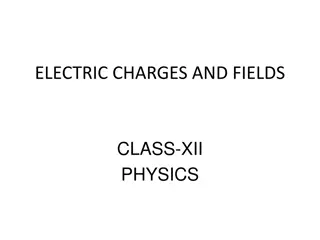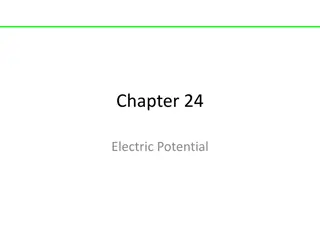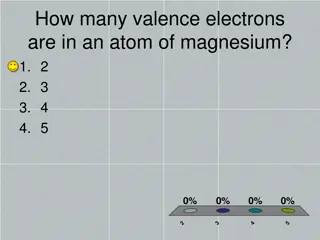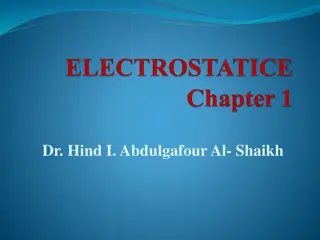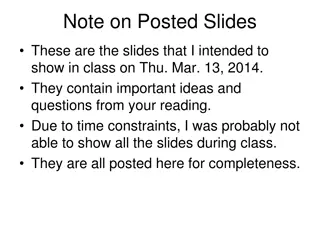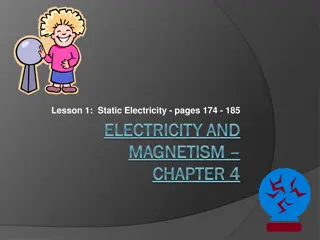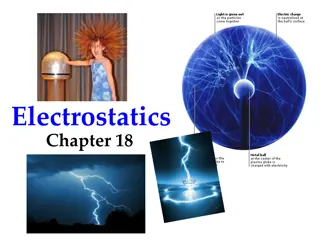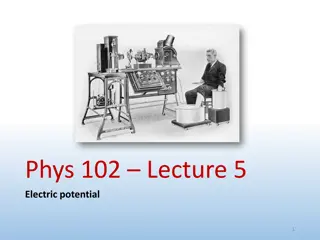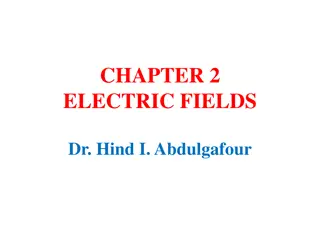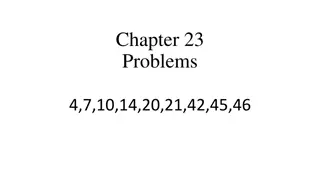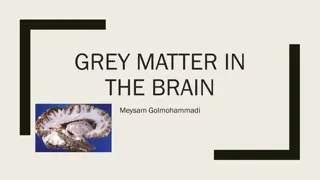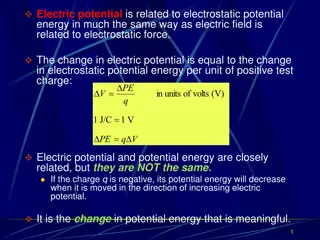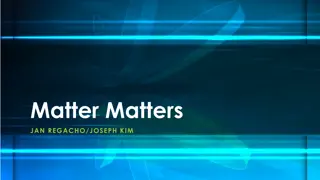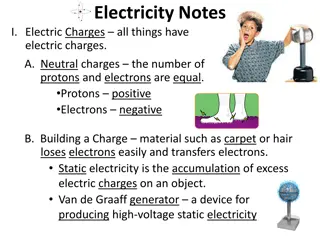Fundamentals of Electric Charges and Matter
This content explores the basic concepts of electrostatics, microstructure of matter, charged objects, transfer of charge, and quantity of charge. It covers topics such as atoms, protons, electrons, ions, and the elementary charge. Understanding these principles is essential in comprehending electricity and its behavior in various systems.
Download Presentation

Please find below an Image/Link to download the presentation.
The content on the website is provided AS IS for your information and personal use only. It may not be sold, licensed, or shared on other websites without obtaining consent from the author.If you encounter any issues during the download, it is possible that the publisher has removed the file from their server.
You are allowed to download the files provided on this website for personal or commercial use, subject to the condition that they are used lawfully. All files are the property of their respective owners.
The content on the website is provided AS IS for your information and personal use only. It may not be sold, licensed, or shared on other websites without obtaining consent from the author.
E N D
Presentation Transcript
8.1 Electricity and Magnetism II Griffiths Chapter 8 Conservation Laws Clicker Questions
8.3 Local conservation of electric charge is expressed mathematically by: r where J is current density = - J J = v has units of (charge/sec)/m2 t We are trying to come up with a conservation of energy expression: (energy density) t = - (something) What sort of beast is this something ? - Is it a scalar, vector, something else? - How would you interpret it, what words would you use to try to describe it? - What are its UNITS? B) J/s C) J/m2 D) J/(s m2) A) J E) Other!
8.4 CT 29.18 A + and - charge are held a distance R apart and released. The two particles accelerate toward each other as a result of the Coulomb attraction. As the particles approach each other, the energy contained in the electric field surrounding the two charges... +Q -Q A: increases B: decreases C: stays the same D: ??
8.5 Uem (outside V) = EM energy in field outside volume V S V d dt ( )=? Uem outside V S dt S dt A) B) outsideV insideV S S D) - S da S da E) S C)
8.6 Can the force from a magnetic field do work on a charge? + v B A) Yes, sure B) Yes, but only if other forces are moving the charge C) Yes, but only if no other forces are moving the charge D) No, never
8.7 A steady current I flows along a long straight wire. E = ? I The parallel component of the E-field, E|| , just outside the surface A) must be zero B) must be non-zero C) might be zero or non-zero depending on details
8.8 FAB = F_onA_fromB FBA = F_onB_fromA B A FAB = FBA Newton s 3rd Law is equivalent to.. A) Conservation of energy B) Conservation of linear momentum C) Conservation of angular momentum D) None of these. NIII is a separate law of physics.
8.9 Two short lengths of wire carry currents as shown. (The current is supplied by discharging a capacitor.) The diagram shows the direction of the force on wire 1 due to wire 2. I2 B2 I1 What is the direction of the force on wire 2 due Fon 1 from 2 to wire 1? A) B) C) D) E) None of these
8.10 B Feynman s Paradox: Two charged balls are attached to a horizontal ring that can rotate about a vertical axis without friction. A solenoid with current I is on the axis. Initially, everything is at rest. n, I The current in the solenoid is turned off. What happens to the charges? Q + R + B A) They remain at rest B) They rotate CW. C) They rotate CCW. Q C Does this device violate Conservation of Angular Momentum? A) Yes B) No C) Neither, Cons of Ang Mom does not apply in this case. I
8.11 Two charged capacitors discharge through wires. The magnetic field forces are not equal and opposite. After the discharge the momentum of the capacitors is to the lower right. What s the resolution of this Newton s Third Law paradox? I2 B1 Answer: Momentum in the EM radiation. When all momentum is included, the center-of-mass of the system remains stationary. Fon 2 from 1 B2 I1 Fon 1 from 2
8.12 t(e0 tuq= - 1 2E2+ B2)- S (Where S=E x B/ 0) 2m0 How do you interpret this equation? In particular: Does the sign on the first term on the right seem OK? A) Yup B) It s disconcerting, did we make a mistake? C) ?? t(uq+e0 2m0 1 2E2+ B2) = - S t(uq+uEM) = - S
8.13 d dt (uq+uEM)dt = - Sdt (Where S=E x B/ 0) Would you interpret S as the A) OUTFLOW of energy/area/time or B) INFLOW of energy/area/time C) OUTFLOW of energy/volume/time D) INFLOW of energy/volume/time E) ???
8.14 d dt (uq+uEM)dt = - Sdt (Where S=E x B/ 0) = - da S Would you interpret S as the A) OUTFLOW of energy/area/time or B) INFLOW of energy/area/time C) OUTFLOW of energy/volume/time D) INFLOW of energy/volume/time E) ???
8.15 What are the SI metric units of the combination of fields E x B/ 0 ? B) J/s C) J/m2 D) J/(m2 s) A) J E) Other!
8.16 The fields can change the total energies of charged particles by: A) Doing work on the particles B) Changing the potential energies only C) Changing the kinetic energies only D) Applying forces only perpendicular to the particle motion. E) None of the above.
8.17 Consider the cylindrical volume of space bounded by the capacitor plates. Compute S = E x B/ 0at the outside (cylindrical, curved) surface of that volume. Which WAY does it point? A) Always inward B) Always outward C) ??? I I
8.18 Given a quantity with units of (Joules/m3), you can convert it to a quantity with units of Joules/(m2 * seconds) by multiplying by: A) a length B) a frequency C) a speed D) an acceleration E) None of the above
8.19 Consider a current I flowing through a cylindrical resistor of length L and radius a with voltage V applied. What is the E field inside the resistor? L a J z s A. (V/L) z-hat B. (V/L) -hat C. (V/L) s-hat D. (Vs/a2) z-hat E. None of the above
8.20 Consider a current I flowing through a cylindrical resistor of length L and radius a with voltage V applied. What is the B field inside the resistor? J J z s A. (I 0/2 s) -hat B. (I 0s/2 a2) -hat C. (I 0/2 a) -hat D. -(I 0/2 a) -hat E. None of the above
8.21 Consider a current I flowing through a cylindrical resistor of length L and radius a with voltage V applied. What is the direction of the S vector on the outer curved surface of the resistor? L a J J z s A. -hat B. s-hat C. z-hat D. ??? And, is it + or -?
8.22 The energies stored in the electric and magnetic fields are: A) individually conserved for both E and B, and cannot change. B) conserved only if you sum the E and B energies together. C) are not conserved at all. D) ???
8.23 The fields can change the total momentum of charged particles by: A) Fields cannot change particle momentum B) Applying a net force to the particles C) Changing only the potential energy D) Only if they do net work on the particles. E) None of the above.
8.24 Consider two point charges, each moving with constant velocity v, charge 1 along the +x axis and charge 2 along the +y axis. They are equidistant from the origin. What is the direction of the magnetic force on charge 1 from charge 2? (You ll need to sketch this! Don t do it in your head!) A. +x B. +y C. +z D. More than one of the above E. None of the above
8.25 Consider two point charges, each moving with constant velocity v, charge 1 along the +x axis and charge 2 along the +y axis. They are equidistant from the origin. What is the direction of the magnetic force on charge 2 from charge 1? (You ll need to sketch this! Don t do it in your head!) A. Equal to the answer of the previous question B. Equal but opposite to the answer of the previous question C. Something different than either of the above.
8.26 We seek a local conservation law that relates the time change in momentum density (units of momentum/m3), to the divergence of a current density, T , with units of: A) Newtons/m2 B) kg*m/(m2*second2) C) Joules/m3 D) More than one of the above E) None of the above
8.27 pEM/volume = m0e0S Momentum in the fields: Consider a charged capacitor placed in a uniform B field in the +y direction x z y +++++++++++++++++++ - - - - - - - - - - - - - - - - - - Which way does the stored field Momentum in this system point? A) +/- x B) +/- y C) +/- z D) Zero! E) Other/???
8.28 pEM/volume = m0e0S Momentum in the fields: Now short out this capacitor with a small wire. As the current flows, (while the capacitor is discharging) x z y +++++++++++++++++++ which way does the magnetic force push the wire (and thus, the system)? A) +/- x B) +/- y C) +/- z D) Zero! E) Other/??? Is your answer consistent with conservation of momentum ? - - - - - - - - - - - - - - - - - -
8.29 What units should a momentum density have? A. N s/m3 B. J s/m3 C. kg/(s m2) D. More than one of the above E. None of the above
8.30 What units should a momentum flux density have? A. N/m3 B. N/m2 C. kg/(s m) D. More than one of the above E. None of the above
8.31 The Maxwell stress tensor is given by: 2dijE2)+1 Tij=e0(EiEj-1 (BiBj-1 2dijB2) m0 What is the E field part of the Tzx term? A. 0(EzEx- (Ex2+Ez2)) B. 0(EzEx- Ey2) C. 0(EzEx- (Ex2+Ey2+Ez2)) D. 0(EzEx) E. None of the above
8.32 The Maxwell stress tensor is given by: 2dijE2)+1 Tij=e0(EiEj-1 (BiBj-1 2dijB2) m0 What is the E field part of the Tzz term? A. 0(Ez2-(Ex2+Ey2))/2 B. 0(Ez2- (Ex2 +Ey2) C. - 0(Ex2+Ey2) D. 0(Ez2) E. None of the above
8.33 Given a general Maxwell Stress tensor with all elements non-zero, what is the net force on a small isolated area element da = (dx dy) z ? F = T dA Txx Tyx Tzx Txy Tyy Tzy Txz Tyz Tzz A. Txz dx dyz B. Tyz dx dy z C.Txz dx dyz D. (Txzx + Tyzy + Tzzz) dx dy E. Something else!
8.34 An infinite plane of surface charge lies in the xz plane. In the region y > 0, which element(s) of the stress tensor is(are) non- zero? z y x A. Tyy B. Txx, Tyy, Tzz C. Txy,Tyx,Tyy,Tyz,Tzy D. Txy,Tyx,Tyy,Tyz,Tzy,Txx,Tyy E. None of the above
8.35 Suppose we have a plane of surface charge with electric field Ea above the plane and Eb below the plane. Ea ++++++++++++++++++++++++++++++ Eb What is the net force per area on the plane? A. (Ea + Eb) B. (Ea - Eb) C. (Ea + Eb) /2 D. (Ea - Eb) /2 E. None of the above




